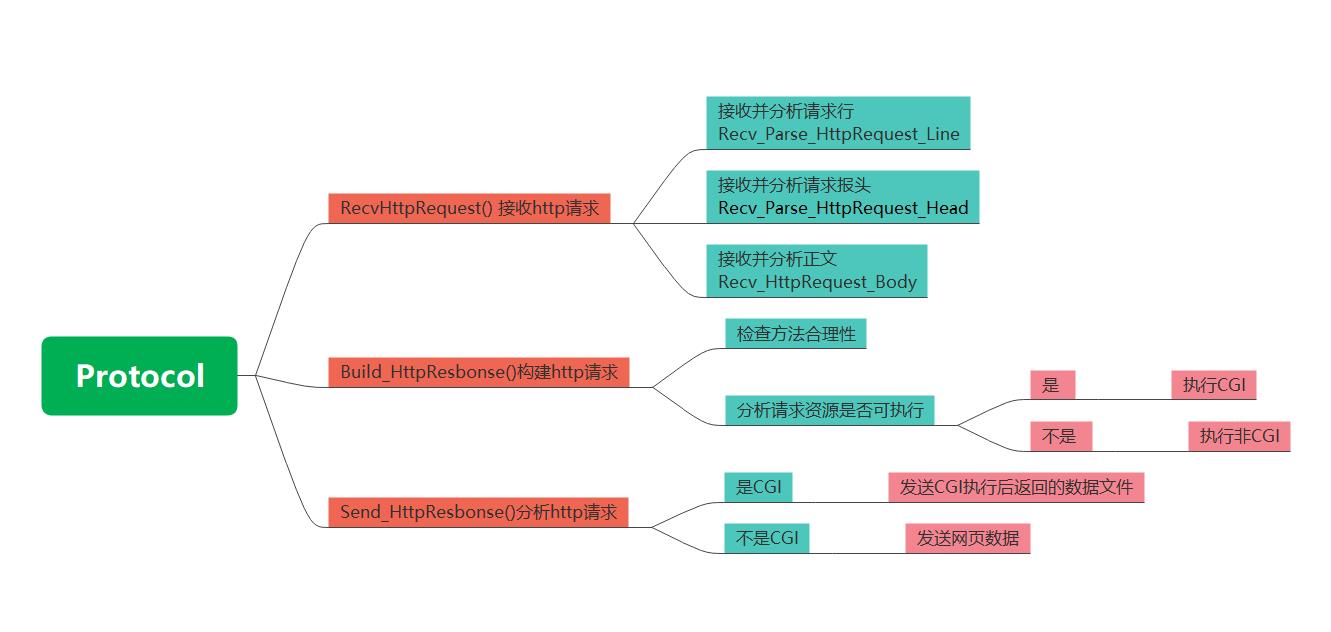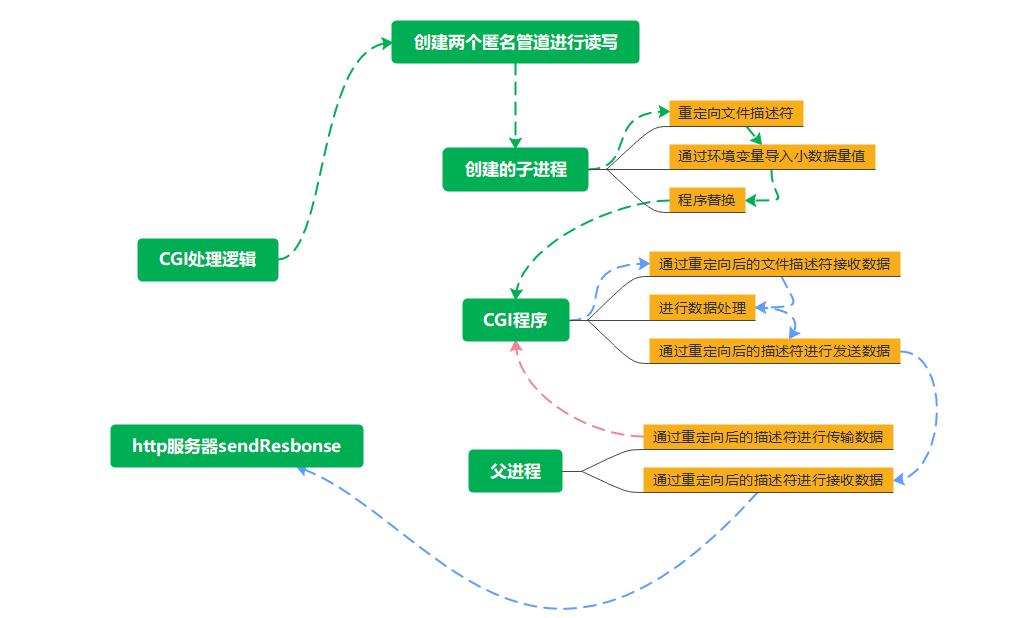自主WebServer实现
Posted 捕获一只小肚皮
tags:
篇首语:本文由小常识网(cha138.com)小编为大家整理,主要介绍了自主WebServer实现相关的知识,希望对你有一定的参考价值。

项目介绍
该项目是一个基于http和tcp协议自主实现的WebServer,用于实现浏览器对服务器的简单请求,然后接收服务器返回的处理请求数据,目的是为了让学习者更好的对网络连接和相关协议进行理解,同时制作出像网络在线计算机,音视频请求播放,或者类似博客的功能,该醒目利用到的主要技术有网络编程(socket),多线程编程,cgi技术,管道通信等
项目框架
TCP_SERVER的搭建
主要是进行监听套接字的创建,然后绑定IP,进行监听,由于是在多线程环境下,我们对tcp_server使用了单例模式
#pragma once
#include <iostream>
#include "LOG.hpp"
#include <sys/types.h>
#include <sys/socket.h>
#include <cstdlib>
#include <cstring>
#include <pthread.h>
#include <netinet/in.h>
#include <arpa/inet.h>
#define PORT 8081
#define BACKLOG 5
class TcpServer
private:
int listen_sock;
int port;
static TcpServer* tcpserver;
private:
TcpServer(int _port = PORT):listen_sock(),port(_port)
~TcpServer()
public:
static TcpServer* GetInstance(int _port = PORT)
static pthread_mutex_t lock = PTHREAD_MUTEX_INITIALIZER;
if(tcpserver == nullptr)
pthread_mutex_lock(&lock);
if(tcpserver == nullptr)
tcpserver = new TcpServer(_port);
tcpserver->InitTcpServer();
pthread_mutex_unlock(&lock);
return tcpserver;
void InitTcpServer()
CreateSock();
BindSock();
ListenSock();
void CreateSock()
listen_sock = socket(AF_INET,SOCK_STREAM,0);
if(listen_sock < 0)
LOG(INFO,"Create Sock Unsucess!");
exit(1);
int opt = 1;
setsockopt(listen_sock,SOL_SOCKET,SO_REUSEADDR,&opt,sizeof(opt));
LOG(INFO,"Create Sock Sucess!");
void BindSock()
struct sockaddr_in local;
memset(&local,0,sizeof(local));
local.sin_family = AF_INET;
local.sin_port = htons(port);
local.sin_addr.s_addr = INADDR_ANY; //云服务器不可以直接绑定ip
if(bind(listen_sock,(struct sockaddr*)&local,sizeof(local))<0)
LOG(INFO,"Bind Sock Unsucess!");
exit(2);
LOG(INFO,"Bind Sock Sucess!");
void ListenSock()
if(listen(listen_sock,BACKLOG)<0)
LOG(INFO,"Listen Sock Unsucess!");
exit(3);
LOG(INFO,"Listen Sock Sucess!");
int GetListenSock()
return listen_sock;
;
TcpServer* TcpServer::tcpserver = nullptr;
http_server的搭建
http_server主要是调用tcp_server进行获取监听套接字,然后接收请求并利用线程池技术进行执行请求
#pragma once
#include "TcpServer.hpp"
#include "Protocol.hpp"
#include "LOG.hpp"
#include "Task.hpp"
#include "ThreadPool.hpp"
#define PORT 8081
class HttpServer
private:
int sock;
int port;
int stop;
TcpServer* tcpserver;
public:
HttpServer(int _port = PORT):port(_port),stop(false),tcpserver(nullptr)
void InitHttpServer()
// 防止对端(client and server)断开发送SIGPIPE信号时,执行默认动作
signal(SIGPIPE,SIG_IGN);
void Loop()
tcpserver = TcpServer::GetInstance(port);
while(!stop)
struct sockaddr_in peer;
socklen_t len = sizeof(peer);
memset(&peer,0,sizeof(peer));
sock = accept(tcpserver->GetListenSock(),(struct sockaddr*)&peer,&len);
LOG(INFO,"Begin Get A New Link!");
if(sock < 0)
LOG(INFO,"Accept Socket Unsucess!");
continue;
LOG(INFO,"Begin Proess Request!");
TASK task(sock);
ThreadPool::GetInstance()->PushTask(task);
~HttpServer()
;
日志系统
主要用来对错误时间进行记录,当程序执行错误时候,可以检查日志系统进行查看排错,然后修正
#pragma once
#include <string>
#include <iostream>
#include <cstdio>
#include <time.h>
#define INFO 1
#define WARNING 2
#define ERROR 3
#define FATAL 4
#define LOG(level,message) log(#level,message,__FILE__,__LINE__)
void log(std::string level,std::string message,std::string fname,int eline)
struct tm t;
time_t now = time(NULL);
localtime_r(&now,&t);
printf("[%-7s][%-4d-%02d-%02d %02d:%02d:%02d][%-30s][%-15s][%-4d]\\n",\\
level.c_str(),t.tm_year+1900,t.tm_mon+1,t.tm_mday,t.tm_hour,t.tm_min,t.tm_sec,\\
message.c_str(),fname.c_str(),eline);
Protocol的搭建
该项目主要分为三个模块,分别是对http的请求进行分析:检测出请求方法,uri等资源路径,请求版本,请求正文;然后按照响应模板进行构建响应;然后返还给客户端;


class EndPoint
private:
int sock;
bool stop;
HttpRequest http_request;
HttpResbonse http_resbonse;
public:
EndPoint(int _sock):sock(_sock),stop(false)
int IsStop()
return stop;
void RecvHttpRequest()
if((!Recv_Parse_HttpRequest_Line()) && \\
(!Recv_Parse_HttpRequest_Head()) && \\
(!Recv_HttpRequest_Body()))
int Recv_Parse_HttpRequest_Line()
LOG(INFO,"Begin Recv Request");
//recv
if(Utility::ReadLine(sock,http_request.request_line)> 0)
http_request.request_line.back() = 0;
LOG(INFO,http_request.request_line);
else
stop = true;
return stop;
//parse
std::stringstream ss(http_request.request_line);
ss>>http_request.method>>http_request.uri>>http_request.version;
//toupper
auto& mt = http_request.method;
std::transform(mt.begin(),mt.end(),mt.begin(),::toupper);
size_t pos = http_request.path.rfind(".");
if(pos != std::string::npos)
http_request.suffix = http_request.path.substr(pos+1);
return stop;
int Recv_Parse_HttpRequest_Head()
//recv
std::string line = "";
while(true)
line.clear();
if(Utility::ReadLine(sock,line)<=0)
stop = true;
return stop;
if(line == "\\n")
http_request.blank = line;
break;
line.back() = 0;
http_request.request_header.push_back(line);
LOG(INFO,line);
//parse
for(auto& item:http_request.request_header)
std::string key,value;
Utility::CutString(item,key,value,": ");
http_request.request_header_kv[key] = value;
return stop;
int Recv_HttpRequest_Body()
auto& mt = http_request.method;
if(mt == "POST")
auto item = http_request.request_header_kv.find("Content-Length");
if(item != http_request.request_header_kv.end())
http_request.content_length = atoi(item->second.c_str());
int size = http_request.content_length;
while(size)
char ch;
size_t s = recv(sock,&ch,1,0);
if(s > 0)
http_request.request_body.push_back(ch);
size--;
else if(s == 0)
break;
else
stop = true;
return stop;
LOG(ERROR,"Recv RequestBody Error");
exit(1);
return stop;
void Build_HttpResbonse()
http_request.path = "wwwroot";
auto& mt = http_request.method;
std::string tmp;
struct stat buf;
//检查方法是否合法
if(mt!= "GET" && mt != "POST")
LOG(INFO,"Request Method Is Not Law!");
http_resbonse.status_code = NOT_FOUND;
goto END;
if(mt == "GET")
//如果是get方法,检查是否带参
size_t pos = http_request.uri.find("?");
if(pos != std::string::npos)
Utility::CutString(http_request.uri,tmp,http_request.query,"?");
http_request.cgi = true;
else
tmp = http_request.uri;
else if(mt == "POST")
tmp = http_request.uri;
http_request.cgi = true;
else
//拼接web根目录
http_request.path += tmp;
if(http_request.path.back() == '/')
http_request.path += "index.html";
//检查资源是否存在
if(!stat(http_request.path.c_str(),&buf))
//检查资源是否是目录
if(S_ISDIR(buf.st_mode))
http_request.path += "/";
http_request.path += "index.html";
stat(http_request.path.c_str(),&buf);
//检查资源是否是可自行文件
else if((S_IXUSR & buf.st_mode)||(S_IXGRP & buf.st_mode)||(S_IXOTH & buf.st_mode))
http_request.cgi = true;
http_request.size = buf.st_size;
else
LOG(INFO,http_request.path +"Resorce Is Not Exist");
http_resbonse.status_code = NOT_FOUND;
goto END;
if(http_request.cgi)
http_resbonse.status_code = HandlerCgi();
else
http_resbonse.status_code = HandlerNonCgi();
END:
Build_HttpResbonseHelper();
int HandlerNonCgi()
auto& path = http_request.path;
http_resbonse.fd = open(path.c_str(),O_RDONLY);
if(http_resbonse.fd > 0)
return OK;
return NOT_FOUND;
int HandlerCgi()
auto& bin = http_request.path;
auto& query_get = http_request.query;
auto& query_post = http_request.request_body;
int upfd[2],downfd[2];
if(pipe(upfd)<0 || pipe(downfd)<0)
LOG(ERROR,"PIPE ERROR");
return ERROR_SERVER;
pid_t pid = fork();
if(pid == 0)
close(upfd[0]);
close(downfd[1]);
dup2(downfd[0],0);
dup2(upfd[1],1);
std::string method = "METHOD=";
method += http_request.method;
putenv((char*)method.c_str());
if(http_request.method == "GET")
std::string query = "QUERY=";
query += query_get;
putenv((char*)query.c_str());
else if(http_request.method == "POST")
int cl = http_request.content_length;
std::string content_length = "CONTENT_LENGTH=";
content_length += std::to_string(cl);
putenv((char*)content_length.c_str());
execl(bin.c_str(),bin.c_str(),nullptr);
exit(1);
else if(pid > 0)
close(upfd[1]);
close(downfd[0]);
std::string& method = http_request.method;
if(method == "POST")
const char* query = query_post.c_str();
ssize_t total = 0,size = 0;
while(total < http_request.content_length && \\
(size = write(downfd[1],query+total,http_request.content_length - total)) > 0)
total += size;
std::string& body = http_resbonse.resbonse_body;
char ch = 0;
while(read(upfd[0],&ch,1) > 0)
body.push_back(ch);
int status = 0;
int ret = waitpid(pid,&status,0);
if(ret == pid)
if(WIFEXITED(status) && !WEXITSTATUS(status))
return OK;
else
LOG(ERROR,"----------");
return ERROR_SERVER;
close(upfd[0]);
close(downfd[1]);
else
LOG(ERROR,"Create SonProcess Unsucess");
return 404;
void Build_HttpResbonseHelper()
int code = http_resbonse.status_code;
auto& status_line = http_resbonse.resbonse_line;
status_line = VERSION;
status_line += " ";
status_line += std::to_string(code);
status_line += " ";
status_line += StatusCodeDesc(code);
status_line += LINE_END;
if(code == 200)
BuildOKResbonse();
else
BuildErrorResbonse(code);
void BuildOKResbonse()
std::string line = "Content-Length: ";
if(http_request.cgi)
line += std::to_string(http_resbonse.resbonse_body.size());
else
line += std::to_string(http_request.size);
line+=LINE_END;
http_resbonse.resbonse_header.push_back(line);
line = "Content-Type: ";
line += SuffixDesc(http_request.suffix);
line += LINE_END;
http_resbonse.resbonse_header.push_back(line);
void BuildErrorResbonse(int code)
http_request.cgi = false;
std::string page = GetErrorFile(code);
std::cout<<"page"<<page<<std::endl;
http_resbonse.fd = open(page.c_str(),O_RDONLY);
if(http_resbonse.fd > 0)
struct stat buf;
stat(page.c_str(),&buf);
http_request.size = buf.st_size;
std::string line = "Content-type: text/html";
line += LINE_END;
http_resbonse.resbonse_header.push_back(line);
line = "Content-Length: ";
line += std::to_string(buf.st_size);
line += LINE_END;
http_resbonse.resbonse_header.push_back(line);
void Send_HttpResbonse()
auto& line = http_resbonse.resbonse_line;
send(sock,line.c_str(),line.size(),0);
for(auto& item : http_resbonse.resbonse_header)
send(sock,item.c_str(),item.size(),0);
send(sock,http_resbonse.blank.c_str(),http_resbonse.blank.size(),0);
if(http_request.cgi)
send(sock,http_resbonse.resbonse_body.c_str(),http_resbonse.resbonse_body.size(),0);
else
sendfile(sock,http_resbonse.fd,nullptr,http_request.size);
close(http_resbonse.fd);
~EndPoint()
close(sock);
;
CGI技术
CGI(Common Gateway Interface)公共网关接口,是外部扩展应用程序与 Web 服务器交互的一个标准接口。它可以使外部程序处理www上客户端送来的表单数据并对此作出反应,通过某些特定的方式处理数据返回给Web服务器进而返回给client端;
一般是把执行资源交给子进程进行程序替换,而不能直接用程序替换,因为这是多线程环境,只要一个进程,如果使用程序替换,那么当前的整个进程将会崩溃(资源没有了)
而cgi程序需要接收父进程交接过来的数据,这里便采用管道通信方式进行数据传递,但这里有个小问题需要注意,我们必须对文件描述符进行重定向,因为被替换后的程序管道只有0,1,2,原先打开的匿名管道被隐藏起来了.
int HandlerCgi()
auto& bin = http_request.path;
auto& query_get = http_request.query;
auto& query_post = http_request.request_body;
int upfd[2],downfd[2];
if(pipe(upfd)<0 || pipe(downfd)<0)
LOG(ERROR,"PIPE ERROR");
return ERROR_SERVER;
pid_t pid = fork();
if(pid == 0) //子进程导入环境变量
close(upfd[0]);
close(downfd[1]);
dup2(downfd[0],0);
dup2(upfd[1],1);
std::string method = "METHOD=";
method += http_request.method;
putenv((char*)method.c_str());
if(http_request.method == "GET")
std::string query = "QUERY=";
query += query_get;
putenv((char*)query.c_str());
else if(http_request.method == "POST")
int cl = http_request.content_length;
std::string content_length = "CONTENT_LENGTH=";
content_length += std::to_string(cl);
putenv((char*)content_length.c_str());
execl(bin.c_str(),bin.c_str(),nullptr);
exit(1);
else if(pid > 0) //父进程写入数据 和 读取数据
close(upfd[1]);
close(downfd[0]);
std::string& method = http_request.method;
if(method == "POST")
const char* query = query_post.c_str();
ssize_t total = 0,size = 0;
while(total < http_request.content_length && \\
(size = write(downfd[1],query+total,http_request.content_length - total)) > 0)
total += size;
std::string& body = http_resbonse.resbonse_body;
char ch = 0;
while(read(upfd[0],&ch,1) > 0)
body.push_back(ch);
int status = 0;
int ret = waitpid(pid,&status,0);
if(ret == pid)
if(WIFEXITED(status) && !WEXITSTATUS(status))
return OK;
else
LOG(ERROR,"----------");
return ERROR_SERVER;
close(upfd[0]);
close(downfd[1]);
else
LOG(ERROR,"Create SonProcess Unsucess");
return 404;
testCGI
#include <iostream>
#include <cstdlib>
#include <string>
#include <unistd.h>
bool GetQuery(std::string& query)
std::string method = getenv("METHOD");
if(method == "GET")
query = getenv("QUERY");
else if(method == "POST")
int content_length = atoi(getenv("CONTENT_LENGTH"));
char ch = 0;
while(content_length)
ssize_t s = read(0,&ch,1);
if(s>0)
content_length--;
query.push_back(ch);
else if(s == 0)
break;
else
return false;
return true;
void CutQuery(std::string& tar,std::string& key,std::string& value,const std::string& sep)
size_t pos = tar.find(sep);
if(pos != std::string::npos)
key = tar.substr(0,pos);
value = tar.substr(pos+sep.size());
int main()
std::string query;
GetQuery(query);
std::string str1,str2;
std::string name1,name2;
std::string value1,value2;
CutQuery(query,str1,str2,"&");
CutQuery(str1,name1,value1,"=");
CutQuery(str2,name2,value2,"=");
std::cout<<name1<<":"<<value1<<std::endl;
std::cout<<name2<<":"<<value2<<std::endl;
return 0;

线程池技术
创建批次num数量的线程进行执行任务队列中的任务,执行逻辑为当任务队列中又任务,那么便竞争锁执行,倘若没有任务,那么所有线程进行等待;
#pragma once
#include <iostream>
#include "Task.hpp"
#include <pthread.h>
#include <queue>
#define NUM 10
class ThreadPool
private:
int num;
std::queue<TASK> TaskQueue;
pthread_mutex_t lock;
pthread_cond_t cond;
ThreadPool(int _num = NUM):num(_num)
pthread_mutex_init(&lock,nullptr);
pthread_cond_init(&cond,nullptr);
ThreadPool(const ThreadPool& TP)
~ThreadPool()
pthread_mutex_destroy(&lock);
pthread_cond_destroy(&cond);
static ThreadPool* tp;
public:
static ThreadPool* GetInstance(int _num = NUM)
static pthread_mutex_t t = PTHREAD_MUTEX_INITIALIZER;
if(tp == nullptr)
pthread_mutex_lock(&t);
if(tp == nullptr)
tp = new ThreadPool(_num);
tp->InitThreadPool();
pthread_mutex_unlock(&t);
return tp;
static void* ThreadRoutine(void* arg)
ThreadPool* tp = (ThreadPool*)arg;
while(true)
TASK task;
tp->Lock();
while(tp->IsEmpty())
tp->ThreadWait();
tp->PopTask(task);
tp->Unlock();
task.ProcessOn();
bool InitThreadPool()
for(int i = 0; i< num;i++)
pthread_t tid;
if(0 != pthread_create(&tid,nullptr, ThreadRoutine,this))
LOG(FATAL,"create pthread unsucess");
return false;
return true;
void Lock()
pthread_mutex_lock(&lock);
void Unlock()
pthread_mutex_unlock(&lock);
void ThreadWait()
pthread_cond_wait(&cond,&lock);
void ThreadWakeup()
pthread_cond_signal(&cond);
bool IsEmpty()
return TaskQueue.size() == 0 ? true:false;
void PushTask(const TASK& task)
Lock();
TaskQueue.push(task);
Unlock();
ThreadWakeup();
//Routine函数中cond_wait用while循环判断主要是解锁和唤醒代码的顺序问题
//如果先解锁,那么就会有其他进程抢到锁开始执行后续,但不一定是等待进程在执行
//所以当后面唤醒等待进程时候,可能会发现任务队列仍然为空,但却继续往下执行,这不符合我们的逻辑
void PopTask(TASK& task)
task = TaskQueue.front();
TaskQueue.pop();
;
ThreadPool* ThreadPool::tp = nullptr;
项目总结
聚焦于处理HTTP的请求和构建对应响应; 我们主要研究基于 HTTP/1.0 短连接 的GET和POST方法;
获得请求,分析请求,错误处理等; 制定特定的网页src用于返回; 引入简单的日志系统
搭建CGI机制;
父子管道,设计dup2重定向,环境变量传参等
引入线程池;
采用多线程技术,缓解内存开销.
源码链接:源码
以上是关于自主WebServer实现的主要内容,如果未能解决你的问题,请参考以下文章